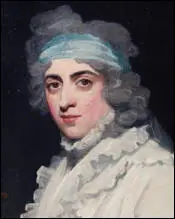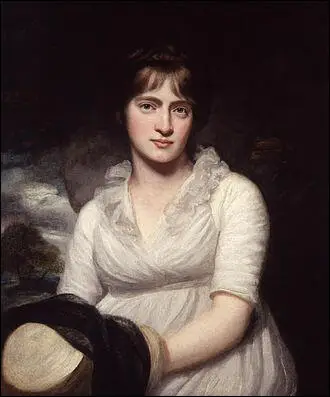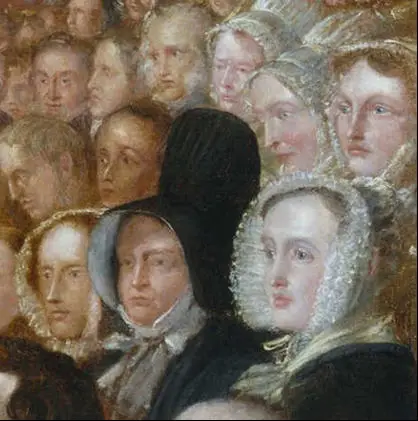Amelia Opie

Amelia Alderson, the only child of James Alderson and his wife, Amelia Briggs Alderson, was born in Norwich on 12th November 1769. Her father was a physician and the son of a dissenting minister in Lowestoft. (1)
As a child Amelia was high spirited and impetuous, traits which her mother, who was "as firm from principle, as she was gentle in disposition" tried to restrain. Her mother was "somewhat of a disciplinarian" and forced her daughter to overcome girlish fears of beetles and frogs by holding them in her hand. (2)
Her mother also brought her up to care for those who came from less privileged backgrounds. After her death on 31st December 1784 she became her father's housekeeper and hostess. According to her biographer, Amelia "was vivacious, attractive, interested in fine clothes, educated in genteel accomplishments, and had several admirers". (3)
Amelia spent her youth writing poetry and plays and organizing amateur theatricals. (4) She took a keen interest in the arts and in 1790 she published anonymously, The Dangers of Coquetry. She was a regular visitor to London and became friends with William Godwin, Mary Wollstonecraft, Elizabeth Inchbald and Thomas Holcroft. (5) During this period she was described by a friend as "universally loved and respected" for uniting "manly wisdom", "feminine gentleness", and "attractive manners". (6)
Radical Reformer
Amelia and her father held strong political and religious views. They were religious dissenters and attended the Octagon Presbyterian Chapel, and associated with the Unitarians. They both supported parliamentary reform and the repeal of the Test and Corporation Acts, which excluded dissenters from public office. In September 1794 some Norwich reformers began a periodical of their own, The Cabinet, and Amelia contributed fifteen poems to the first three issues. (7)
Three of her political friends, John Horne Tooke, Thomas Hardy and John Thelwall began to organise a convention to discuss parliamentary reform. When the authorities heard what was happening, Tooke and the other two men were arrested and committed to the Tower of London and charged with high treason. The trial began at the Old Bailey on 28th October, 1794. The prosecution argued that the men were guilty of treason as they organised meetings where people were encouraged to disobey King and Parliament. However, the prosecution was unable to provide any evidence that Tooke and his co-defendants had attempted to do this and the jury returned a verdict of "Not Guilty". (8) It is claimed that if the men had been found guilty Amelia would have emigrated to the United States. (9)
Amelia Opie - Novelist
John Opie was a successful portrait artist who came from a working-class background. He was married to Mary, the daughter of Benjamin Bunn, a solicitor and moneylender. According to Mary Wollstonecraft the marriage was unhappy as "she was too much of a flirt to be a proper companion for him". They divorced in 1796 and he married Amelia on 8th May 1798. (10)

Amelia Opie continued to write and her novel, The Father and Daughter was published in 1801. It told a story of how a daughter's seduction sent her father mad. It sold 9,500 copies in 35 years. This was followed by Adeline Mowbray: Mother and Daughter (1804). The novel concerns a women who lives to repent her rejection of marriage. (11) Claire Tomalin has argued that both these novels were attacks on the lives of Mary Wollstonecraft and William Godwin. (12)
In 1805 John Opie became professor at the Royal Academy. His lectures were well regarded but unfortunately he died on 9th April 1807. His biographer, Robin Simon, claimed that "Opie's death, which followed the intense preparation of these lectures, and his customary incessant painting, has been partly at least attributed to overwork." (13)
Opie continued to write poetry, short-stories and novels. This included Temper, or, Domestic Scenes: a Tale (1812), Tales of Real Life (1813), Valentine's Eve (1816), New Tales (1818), Tales of the Heart (1820) and Madeline: a Tale (1822). Her novels made Opie the most respected woman fiction writer after Maria Edgeworth. (14)
Amelia Opie's beauty continued to attract the attentions of men. The young dramatist Edward Fitzball saw that "she was worshipped in society, not only for her great talent and her polished manners, but for her peculiar beauty... she was so voluptuous, yet so delicate and feminine, especially when she sang". (15) Anna Eliza Bray commented that she had rarely encountered a woman "of such fascinating powers of conversation". (16)
Anti-Slavery Movement
Amelia developed a close relationship with Joseph Gurney, a minister for the Society of Friends. Under his influence she became active in the campaign against the slave-trade. On 8th April, 1825, Lucy Townsend, Elizabeth Heyrick, Mary Lloyd, Sarah Wedgwood and Sophia Sturge formed the Birmingham Ladies Society for the Relief of Negro Slaves (later the group changed its name to the Female Society for Birmingham). (17) The group "promoted the sugar boycott, targeting shops as well as shoppers, visiting thousands of homes and distributing pamphlets, calling meetings and drawing petitions." (18)
The society which was, from its foundation, independent of both the national Anti-Slavery Society and of the local men's anti-slavery society. As Clare Midgley has pointed out: "It acted as the hub of a developing national network of female anti-slavery societies, rather than as a local auxiliary. It also had important international connections, and publicity on its activities in Benjamin Lundy's abolitionist periodical The Genius of Universal Emancipation influenced the formation of the first female anti-slavery societies in America". (19)
The formation of other independent women's groups soon followed the setting up of the Female Society for Birmingham. Amelia Opie and Anna Gurney established a group in Norwich. Other groups were formed in Nottingham (Ann Taylor Gilbert), Sheffield (Mary Ann Rawson, Mary Roberts), Leicester (Elizabeth Heyrick, Susanna Watts), Glasgow (Jane Smeal), London (Mary Anne Schimmelpenninck, Mary Foster), Darlington (Elizabeth Pease) and Chelmsford (Anne Knight). By 1831 there were seventy-three of these women's organisations campaigning against slavery. (20)
Amelia Opie was now a very committed Quaker. Mary Russell Mitford commented that Amelia "is all over Quakerized", though "just as kind and good-humoured as ever" and after "about a quarter of an hour's chat" able to forget "her thee's and thou's" and "altogether as merry as she used to be". Opie put her energies into the kind of philanthropic work promoted by Quakers. "She visited workhouses, hospitals, prisons, and the poor; promoted a refuge for reformed prostitutes." (21)
The Slavery Abolition Act was passed on 28th August 1833. This act gave all slaves in the British Empire their freedom. The British government paid £20 million in compensation to the slave owners. The amount that the plantation owners received depended on the number of slaves that they had. For example, Henry Phillpotts, the Bishop of Exeter, received £12,700 for the 665 slaves he owned. (22)
Amelia Opie attended the World Anti-Slavery Convention held at Exeter Hall in London, in June 1840 but as a woman was refused permission to speak. Anne Knight became aware that the artist, Benjamin Robert Haydon, had started a group portrait of those involved in the fight against slavery. She wrote a letter to Lucy Townsend complaining about the lack of women in the painting. "I am very anxious that the historical picture now in the hand of Haydon should not be performed without the chief lady of the history being there in justice to history and posterity the person who established (women's anti-slavery groups). You have as much right to be there as Thomas Clarkson himself, nay perhaps more, his achievement was in the slave trade; thine was slavery itself the pervading movement." (23)
When the painting was completed it did not include Lucy Townsend or most of the leading female campaigners against slavery. Clare Midgley, the author of Women Against Slavery (1995) points out that as well as Anne Knight and Lucretia Mott, it does feature Amelia Opie, Elizabeth Pease, Mary Anne Rawson and Annabella Byron: "Haydon's group portrait is exceptional in that it does record the existence of women campaigners. Most other memorials did not. There are no public monuments to women activists to complement those to William Wilberforce, Thomas Clarkson and other male leaders of the movement... In the written memoirs of these men, women tend to appear as helpful and inspirational wives, mothers and daughters rather than as activists in their own right." (24)

showing from left to right, bottom row: Annabella Byron, Amelia Opie,
Mary Anne Rawson, top row, Anne Knight, Mrs John Beaumont and Elizabeth Pease.
Amelia continued to take an interest in literature and loved reading the work of Charles Dickens and Thomas Carlyle. In 1851 she went around the Great Exhibition in a wheelchair and, meeting Mary Berry in a similar vehicle, challenged her to a race. She wrote letters constantly, estimating in 1849 that she averaged six a day plus notes, and she maintained the custom of sending anonymous Valentines. She holidayed at Cromer and attended criminal trials at London and Norwich. (25)
Amelia Opie died after a short illness on 2nd December 1853.
Primary Sources
(1) Elizabeth Heyrick, Immediate not Gradual Abolition (1824)
In the great question of emancipation, the interests of two parties are said to be involved, the interest of the slave and that of the planter. But it cannot for a moment be imagined that these two interests have an equal right to be consulted, without confounding all moral distinctions, all difference between real and pretended, between substantial and assumed claims. With the interest of the planters, the question of emancipation has (properly speaking) nothing to do. The right of the slave, and the interest of the planter, are distinct questions; they belong to separate departments, to different provinces of consideration. If the liberty of the slave can be secured not only without injury, but with advantage to the planter, so much the better, certainly; but still the liberation of the slave ought ever to be regarded as an independent object; and if it be deferred till the planter is sufficiently alive to his own interest to co-operate in the measure, we may for ever despair of its accomplishment. The cause of emancipation has been long and ably advocated. Reason and eloquence, persuasion and argument have been powerfully exerted; experiments have been fairly made, facts broadly stated in proof of the impolicy as well as iniquity of slavery, to little purpose; even the hope of its extinction, with the concurrence of the planter, or by any enactment of the colonial, or British legislature, is still seen in very remote perspective, so remote that the heart sickens at the cheerless prospect. All that zeal and talent could display in the way of argument, has been exerted in vain. All that an accumulated mass of indubitable evidence could effect in the way of conviction, has been brought to no effect.
It is high time, then, to resort to other measures, to ways and means more summary and effectual. Too much time has already been lost in declamation and argument, in petitions and remonstrances against British slavery. The cause of emancipation calls for something more decisive, more efficient than words. It calls upon the real friends of the poor degraded and oppressed African to bind themselves by a solemn engagement, an irrevocable vow, to participate no longer in the crime of keeping him in bondage...
The perpetuation of slavery in our West India colonies is not an abstract question, to be settled between the government and the planters; it is one in which we are all implicated, we are all guilty of supporting and perpetuating slavery. The West Indian planter and the people of this country stand in the same moral relation to each other as the thief and receiver of stolen goods.
The West Indian planters have occupied much too prominent a place in the discussion of this great question....The abolitionists have shown a great deal too much politeness and accommodation towards these gentlemen.... Why petition Parliament at all, to do that for us, which... we can do more speedily and effectually for ourselves?
Student Activities
Child Labour Simulation (Teacher Notes)
Richard Arkwright and the Factory System (Answer Commentary)
Robert Owen and New Lanark (Answer Commentary)
James Watt and Steam Power (Answer Commentary)
The Domestic System (Answer Commentary)
The Luddites: 1775-1825 (Answer Commentary)
The Plight of the Handloom Weavers (Answer Commentary)
Road Transport and the Industrial Revolution (Answer Commentary)

